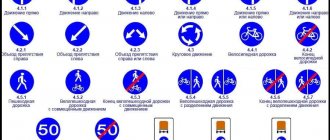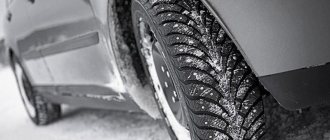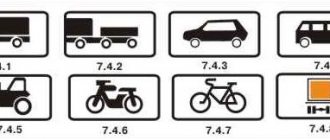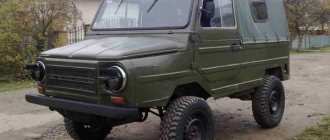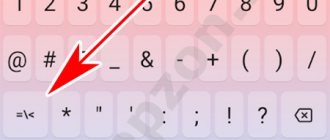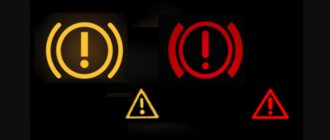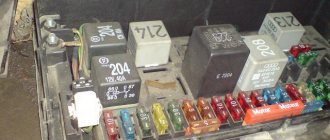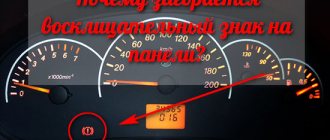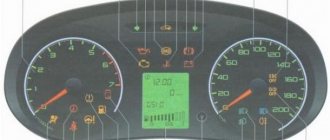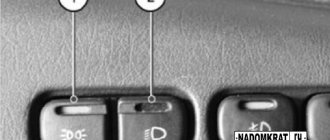Everyone on the road often encounters a white sign with a red border on a white background. But what does it mean? Let's try to give an explanation.
The designation in the collection “Road Signs” is sign 3.2 Traffic is prohibited. Where a similar road sign is placed, a white circle with a red border, traffic is prohibited. Here are the main reasons for this;
- Forbidden territory.
- Parking lots intended for official vehicles or transport of building residents.
- Traffic control in courtyards, schools, kindergartens, etc.
- Road repair.
- Carrying out various events.
In practice, this means that if you enter the territories marked with sign 3.2 without having a valid reason, at best you can receive a warning.
As a rule, driving on both sides of the road is prohibited; The main difference from the well-known “brick”, which can be installed anywhere, and the road sign is a white circle with a red border - only on a two-way traffic area.
The road sign, a white circle with a red border, does not have a strict covering - the end of the action is considered to be the installation of the corresponding duplicate sign with a mark indicating the end of the action, or the first intersection. Less often - the end of the road with an adjacent sign.
Such a sign may be supplemented with additional signs;
1. Sign 8.3.1-3 with arrow indications of the further direction of action.
2. Sign 8.5.1-4, indicating the duration of the installed road sign 3.2.
Used when carrying out events, repair work and other things on the covered section of the road.
What does the traffic prohibited sign mean?
Sign 3.2 belongs to the prohibitory category and means that the movement of any vehicles is not allowed on the section of road that begins behind it. It “cuts off” traffic in both directions , that is, a fine will be imposed for entering and exiting under a traffic prohibited sign.
Traffic regulations determine that a “No Traffic” sign is needed before a side exit onto the road; in addition to it one of the signs is installed ( 8.3.1.-8.3.3. )
Dimensions and markings according to GOST
To create a road sign, technical specifications are taken from GOST.
According to the rules, it goes under number 3.2 in the list of designations. According to the requirements, size 1 with a diameter of 600 millimeters is used. This is a circle with a red border, which also has its own size - 0.1 diameter. The interior is lined in white. At the bottom there are often small black tables indicating the restricted area and movement arrows.
According to legal standards, the colors used for road signs must be clearly visible in the light and dark, bright and saturated (not “poisonous”). The materials used in manufacturing must be durable and impact-resistant. Similar colors and sizes are necessary for the “visibility” of the object by the driver and pedestrian (traffic participants).
Perhaps, from 2022, other designations will be used, in which additional information is placed at the bottom of the road sign itself. Many experts are against innovation due to the low visibility of the object.
Sign area
To the intersection or to the sign that would cancel the action . The “No Traffic” sign has certain coverage areas:
- when entering closed and restricted areas;
- where repair work is going on;
- if in honor of a holiday or significant date this area is planned to be pedestrianized;
- in front of yards (may be accompanied by a “dead end” sign).
Freight transport also has its limitations. You can find out more about them here.
We remind you that there are places where you cannot drive or park even without this sign:
- sidewalks (parking fine);
- parking on the lawns.
Interesting Facts
Palau, India, and Laos are often named among the countries that have a daylight on their national flag. However, this data is erroneous, since on the state symbol:
- Palau depicts another celestial body - the full Moon.
- India - wheel of law (Dharma Chakra).
- Laos - white circle as a sign of unity.
This confusion arises due to the external similarity of the mentioned images with the sun. The solar cult has been known since ancient times. For our ancestors, the star of day is associated with such concepts as energy, source of life, light, heat. Sunlight represents knowledge and truth. In ancient times, all religions had a cult of the sun, they worshiped and revered him as the highest deity (Inca Inti, Egyptian god Ra, Slavic Yarilo, etc.). The sun still has positive symbolism with all its diversity of meanings, which is confirmed by vexillology.
Exceptions
The “No Traffic” sign has exceptions - “more equal than others” in this case will be:
- Russian Post cars with a characteristic identification mark (diagonal white stripe on a blue background);
- route transport;
- cars transporting disabled people ( groups 1 and 2 , no matter in what capacity - driver or passenger);
- cars of citizens permanently residing in this zone or servicing enterprises located in it.
Of course, have documents with you proving that this ban does not apply to you .
For example, invoices, certificates, passport with registration. As for disabled people, we are talking not only about documents confirming their status - that goes without saying.
itself must be equipped with appropriate signs indicating that people with disabilities are driving it.
Keep in mind that the “road guard” will most likely stop the person driving under the limiter. After which he will ask for documents and if they are not available, then a fine will be issued for driving under the “no traffic” sign.
Traffic regulations 1.2.
Prohibiting road sign 3.2 Prohibited traffic prohibits the movement of relevant types of vehicles in both directions.
The prohibition sign does not apply
The effect of the prohibitory sign 3.2 Traffic prohibited does not apply to route vehicles.
The effect of the prohibitory sign 3.2 Traffic is prohibited does not apply to vehicles of federal postal service organizations that have a white diagonal stripe on a blue background on the side surface, and vehicles that serve enterprises located in the designated area, and also serve citizens or belong to citizens living or working in the designated area. In these cases, vehicles must enter and exit the designated area at the intersection closest to their destination.
The effect of the prohibition sign 3.2 Traffic is prohibited does not apply to vehicles driven by disabled people of groups I and II, to vehicles transporting such disabled people or disabled children.
Fine
What is the fine for driving under a “No Traffic” sign? Not that big, only 1,500 rubles ( Article 12.16 of the Code of Administrative Offenses of the Russian Federation ). Why so few? The authorities believe that despite the violation of the “no movement” sign, this act in itself is not dangerous and the driver does not create an emergency situation. After all, no other cars are expected to be in this zone. But neglecting the “brick” threatens with deprivation of rights.
Here you will find information about other fines for traffic violations.
Variety of images
Having become acquainted with the symbolism of the sun on the flags of the world, it can be noted that the image of the luminary differs in:
Color:
- Yellow (Kyrgyzstan, Kazakhstan, Argentina, Uruguay, Kiribati, Antigua and Barbuda, Philippines, Namibia, Rwanda), including Jamaica, Guinea, Uganda, Seychelles and North Macedonia.
- Red (Japan, Bangladesh, Malawi).
- White (Nepal, Taiwan).
- Orange (Niger).
Shape:
- Circle with rays (Kyrgyzstan, Kazakhstan, Argentina, Uruguay, North Macedonia, Philippines, Taiwan, Namibia, Rwanda).
- Circle without rays (Bangladesh, Japan, Niger).
- Half disk (sunrise) (Malawi, Kiribati, Antigua and Barbuda).
- Star-shaped (Nepal, Antigua and Barbuda).
- In the form of a strip (Guinea, Uganda, Jamaica, Seychelles).
Number of rays:
- Even: 40 (Kyrgyzstan), 32 (Kazakhstan, Argentina), 24 (Rwanda), 16 (Uruguay, Antigua and Barbuda), 12 (Nepal, Taiwan, Namibia), 8 (North Macedonia, Philippines).
- Odd: 31 (Malawi), 17 (Kiribati).
- And “0” (Japan, Bangladesh, Niger).
Shape of rays: straight, wavy, drop-shaped, grain-shaped, a combination of straight and wavy.
Semantic meaning: in addition to the direct meaning - the luminary of the day, it is also the personification of energy, prosperity, enlightenment, a new era, equality, but most often this symbol is given a revolutionary liberation meaning.
This colorful diversity is explained by the desire of the authors to most fully reflect the meaning of the symbol on the national flag, as well as to create a unique, bright, memorable image, unlike others that already exist.
How can traffic police officers prove this offense?
Usually they don’t have to prove anything - a traffic police patrol is located nearby, which records the offense. After which the car, which risked not noticing the eloquent sign, is stopped in order to find out what the reason is. Or the fact of illegal entry was “caught” by a video camera.
As for challenging it , it is practically impossible . It's better to tune in to this right away. Unless you have a document proving that you had the right to go .
Or the camera does not recognize that the car is yours (for example, unreadable license plates). It's a different matter if you are faced with arbitrariness .
For example, you are a forwarder for a store that is located right in the disputed territory, you have papers with you confirming the fact of your work - but you are still detained .
Or the “road guard” claims, despite your registration, that there is another road to your area and you have the right to use only that one. Or even worse, they confiscate your rights.
Don't be rude to the policeman, but don't give him your driver's license either. Record everything that happens on a camera or video recorder - the audio recording will not be accepted as evidence in court.
Don't rush to sign . You can also request that a protocol be written out and sent to you by mail at the place of registration . It’s easier to try to challenge it this way than if you were “accepted” before the circumstances were clarified. If this happens, contact a lawyer as soon as possible.
Still, the best option is not to ignore the prohibitions. After all, as driving instructors say, all these rules are written in blood. contact a competent car lawyer for advice as soon as possible .
In order to drive correctly and not endanger yourself and others, the driver needs to know and follow many traffic rules:
- turn on low beams during daylight hours;
- do not cross double continuous markings;
- fasten seat belts;
- allow pedestrians to pass;
- do not drive through a red traffic light;
- do not exceed the speed limit.
Krasnaya Polyana (Sochi) in winter 2022: hotels
At Krasnaya Polyana
There are no budget hotels in Krasnaya Polyana (Sochi) in winter. The minimum cost of living in this place, in close proximity to the ski resort, will start from 5,000 rubles. per day and that’s if you’re lucky.
You need to book rooms in advance, at least a month before travel. But here you are guaranteed to live not only close to the ski slopes, but also take advantage of the best service of brand new hotel complexes, restaurants, cafes and the latest infrastructure with an ideal layout.
In Adler
In Adler you can rent a room, stay in a guest house, a private hotel equivalent to a three-star rating, or a sanatorium. Moreover, in the latter you can also take advantage of all medical procedures, as during a beach holiday. In Adler you can also visit the Olympic village and the Amusement Park, the oceanarium, parks and walk along the embankment. In short, diversify your daytime stay in the mountains with an evening relaxation on the seashore.
You can rent a room at this time from 600-700 rubles. per person per day. Guest house from 1200 rub. per day. A three-star hotel starts from 1,600 rubles, and a sanatorium from 2,000 rubles. There are no very expensive restaurants in Adler, but there are many canteens and cafes. You can have a full meal there from 120 rubles, depending on the establishment. Most of the cafes on the embankment are closed for the winter, and only a small part is open.
You can get from Adler to the ski resort by high-speed train in 40 minutes. The ticket price will be 350 rubles. for an adult and 175 rub. for children. Buses also run, and a ticket costs about 150 rubles.
In Sochi
In Sochi, as in Adler, applicants for a ski holiday in Krasnaya Polyana (Sochi) in winter can stay at a sanatorium and combine relaxation with treatment. Prices start from 2500 rubles. during the ski season. There are more good hotels here than in Krasnaya Polyana and they are a little cheaper, and it is also much easier to book a hotel, although it is better to make arrangements in advance. Prices will start from 4000 rubles.
There are much fewer small private hotels and guest houses here than in the resorts of Greater Sochi, but they are present. In winter you can stay in them from 1800 -2000 rubles. You can get to Krasnaya Polyana by high-speed train “Lastochka” in about 1 hour 20 minutes. Ticket price for an adult is 435 rubles. and 217 rub. for children.
| We made a detailed review about online excursions during quarantine here. You can order it for one person and watch it with the whole family. When you book an excursion on Tripster, you will also receive a discount on the offline excursion (the discount is valid indefinitely). |
There are good restaurants and cafes in Sochi, and their prices are quite high, since holidays here are aimed at wealthy tourists. The average bill for a set dinner starts from 2000 rubles. In a cafe, if you wish, you can spend 1000 rubles. no savings. There are few canteens, the average bill is about 200 rubles, but there is a McDonald's on the corner of the street. Poyarko and Kurortny Prospekt, next to the park.
Dagomys, Matsesta, Khosta
In other resorts of Greater Sochi, such as Dagomys, Matsesta and Khosta, the number of cheap hotels and guest houses is much greater than in Adler and the center of Sochi. Food is cheaper and holiday seekers can also stay in a sanatorium in Krasnaya Polyana (Sochi) in winter.
Getting to the ski resort from here is difficult. From Dagomys to Sochi station it is about 10 km by bus or minibus, since the high-speed train does not go there. The only plus is that due to its remoteness, you can find the cheapest housing here in the winter season.
Flat rent
You can rent an apartment in all areas of Greater Sochi. There are many offers, but the demand is still not as high as in the summer season. But many travelers still prefer to stay in hotels. Therefore, in winter, apartments are usually rented out by the month and cost from 15,000-25,000 rubles, depending on the building, location and quality of finishing of the housing.
You can rent an apartment for a month by partnering with someone who will move in after you and vice versa. An apartment can also be rented on a daily basis. Depending on the area of Greater Sochi, rent costs from 1200 to 1800 rubles. per day for a one-room apartment. The best prices are in Dagomys, then Khosta, Matsesta, Adler and Sochi.
Prohibiting
As the name of the group implies, the signs prohibit the driver from performing any action: passing, turning, overtaking, accelerating, stopping. All prohibition signs are round in shape.
The fines for each sign are different, depending on the situation. For example, entering a closed area under a “brick” is punishable by a fine of 1 thousand rubles for violating the instructions of the sign. And for driving under a “brick” into the oncoming lane, your license will be taken away for 2-4 years.
Cars that have turned on special signals and flashing lights can ignore prohibition signs. The validity of the signs ends at the nearest intersection or at signs that cancel previously introduced restrictions.
The importance of knowing road signs cannot be underestimated, since they provide the driver with comprehensive information related to road traffic.
These information images indicate what is prohibited, what is allowed on a given section of the road, inform and warn the driver about the danger.
They are divided into nine groups:
- Warning. As the name suggests, the purpose of these types is to inform about dangers on a section of the road in order for the driver to take appropriate measures to ensure the safety of themselves, passengers and pedestrians.
- Priority signs. Indicate to drivers the order of passage through narrow road sections and intersections.
- Prohibiting. Appropriate traffic restrictions are introduced and also lifted.
- Prescriptive. Establish mandatory driving conditions on a lane or section of road.
- Special instructions. Designed to organize a certain traffic mode, or cancel it.
- Additional Information. These are signs used in conjunction with other types, complementing or clarifying the actions of the latter.
- Information types.
- Identification varieties.
- Service.
Below we will look in detail at the “No Parking” type, which is classified as prohibiting, so first we will take a closer look at this broad group.
Outwardly, it is very simple to distinguish them - a circle with a red border on a white or blue background, which is quite difficult not to notice. This is a very large group that regulates literally all aspects of road traffic, starting from the maximum permissible speed, restrictions on the weight and types of vehicles, and ending with the ban on entry, parking and stopping of cars on various sections of the road.
It is important not only to confidently imagine what prohibitory signs look like and what exactly they prohibit, but also to understand exactly on which sections of the roadway they operate, that is, to imagine the area of effect of the sign. Let's first figure out where the zone of action of the prohibiting species begins.
Here, unlike warning types, everything is very simple - the ban begins to operate immediately after the place where the image is installed, and it does not matter what exactly it means - the maximum permissible speed or a parking ban.
Of course, there are exceptions to any rule. So, for example, the “Parking is prohibited” type, established at the entrance to the yard, does not apply to persons living in the house or working in an organization located here, if a detour is not provided. There are other exceptions related to the action of this sign, which will be discussed below.
This road symbol can be found very often - a blue circle with a red border, crossed diagonally by one red stripe. It is clear that it prohibits parking of vehicles on any day of the week.
But sometimes you can find it prohibiting parking, for example, only on odd days, or even days - on them one or two white stripes (vertical) are drawn inside a crossed out circle. Accordingly, one lane is crossed out - you cannot park a car only on odd days, two - on even days.
However, there are restrictions here too - the ban is valid only until the evening - until 19.00, so in order not to break the rules, before 21.00 the vehicle must be driven to the other side of the road - as a rule, a sign with a reverse restriction is installed on it.
Well, in the period from 19.00 to 21.00 you can park your car in the coverage area of any sign - you will not break the rules. It should also be noted that there are categories of people who can safely ignore the “Parking Prohibited” symbol.
We will not describe in detail the rules for federal postal vehicles, for which this type does not apply - this is not relevant for us. It is much more important that cars of disabled people of groups I and II and persons transporting such disabled people can park under this graphic element without fear.
This type, so to speak, is closely related to the road sign we described above. The fact is that where stopping is prohibited, parking is also prohibited, but not vice versa.
You can stop in a “No Parking” zone and you won’t be fined. Let's take a brief look at how a parking lot differs from a stop.
There are no difficulties here, since this issue is covered in some detail in the traffic rules. Understanding the differences between parking and stopping is very simple.
But if at the same time you perform actions related to boarding/disembarking passengers, loading/unloading a car, then regardless of how much time it takes you, you will make a stop, not a parking lot, even if it lasts at least 15 minutes, at least a whole hour.
Externally, “Parking and stopping is prohibited” is very similar to the prohibitory type we described above, only it is no longer one diagonal red stripe on a blue background, but two intersecting stripes.
It also applies only to its own lane. Exceptions to which this symbol does not apply include only route vehicles. Please note that disabled people in their vehicles can no longer stop in the coverage area of this element, unless, of course, a corresponding information sign is installed under it.
In general, its coverage area is the same as that of other prohibitory images, that is, from the installation site to the first intersection, or to the end of the populated area, if no other symbols are installed that remove the restriction.
However, there are nuances:
- Firstly, the zone can be defined by a yellow broken marking line at the edge of the roadway: as long as it is there, parking is prohibited, and with the end of this line, the sign’s coverage area ends.
- Secondly, at the beginning of the article it was not for nothing that we briefly mentioned other road types, in particular, signs used in conjunction with other types to clarify the action of the latter.
Thus, the coverage area signs (vertical arrows on a white rectangle), located under the sign, precisely determine its coverage area.
Thus, if under the graphic element “Parking Prohibited” you see an arrow pointing down, this means the end of the sign’s coverage area - it will be possible to leave a vehicle behind it, unless, of course, other traffic rules are violated.
If the sign indicates an arrow pointing upward, this means that the coverage area will begin from the location where the sign is installed, but you can also usually see a number indicating the length of the coverage area in meters.
The direction of movement to which the sign applies is also important.
At the same time, remember also about the “Parking Restricted Zone” view, which is a large white rectangle with a “No Parking” sign drawn inside it - it already applies to the entire roadway.
The parking ban is also canceled by the “End of all restrictions zone” pictogram - a white circle with black stripes crossing it out. By the way, there is a similar sign for the above-mentioned “Parking Restriction Zone”.
The Code of Administrative Offenses states that ignoring requirements of this type provides for a fine of 1,500 rubles. And if the offense was committed in Moscow or St. Petersburg, then the fine will already amount to 3,000 rubles.
In addition, the car can easily be sent to a penalty area. In order to receive a fine for illegal stopping or parking, by the way, it is not at all necessary to stop in the area covered by the relevant signs.
If you happen to, for example, leave your car closer than five meters to a pedestrian crossing or on it itself, then you will be given the same fines.
We mentioned above that “No parking” can be installed in conjunction with information signs.
They are divided into a couple of groups:
- Indicating the type of vehicle for which parking is prohibited. These can be motorcycles, trucks, trucks with trailers, route vehicles, etc.
- Coverage area signs. These are vertical arrows on a white background that can point up, down, or both ways. They indicate the direction of the zone in which the sign is valid. Sometimes the sign additionally indicates the distance of the coverage area in meters.
To protect yourself from monetary losses caused by exorbitant fines and costs of “rescuing” a car from a parking lot, do not neglect the parking rules determined by the corresponding information symbols on the road, markings, etc.
After all, failure to comply with these requirements can cause accidents on the road, numerous casualties, and simply create traffic jams that get on your nerves when driving through a densely populated city. Therefore, do not break the rules, leave your car in the parking lot only in permitted places.
We also recommend watching
And, on the contrary, a sign similar in name, which is called only 3.1 Entry is prohibited or Brick, according to the traffic rules, does not allow any movement in its direction to anyone, except for route transport, even disabled people or residents of nearby houses. And, such a violation of traffic rules may result in the deprivation of a driver’s license.
Warning
Warning signs are triangular in shape, white with a red edge. The only exceptions to this rule are signs indicating railroad crossings and turning directions.
The requirements of warning signs cannot be violated because they do not prohibit anything. The purpose of these signs is to warn the driver of approaching danger. For example, about the narrowing of the road ahead, the possibility of animals entering the road, slippery roads and dangerous turns.
Such signs are installed 50-300 m from the danger, depending on where it is located - in the city or on the highway.
Esto-zadok - summer vacation
A village located 5 kilometers from Krasnaya Polyana is Esto-zadok, local residents also call it Estonka. Major ski resorts are located here: Gorki Gorod, Rosa Khutor, Alpika - Service and Gazprom. Summer holidays here are attractive due to relatively low prices, because the main specialization of these tourist centers is the winter season. Where will you go and what can you see in Krasnaya Polyana in the summer?
You can visit the house-museum of the Estonian novelist. The house preserves the unique furnishings of the late nineteenth and twentieth centuries, giving an idea of the lifestyle, traditions and crafts of immigrants from Estonia. The museum displays photographs and documents from those times, documenting the daily life of days gone by.
What to see on your own in summer in Krasnaya Polyana? You should definitely go on an excursion to the Mountain Garden apiary. It was thanks to her that the village got its name. A special type of bee, the gray Caucasian bee, collects pollen here. The bee farm "Mountain Garden" is recognized as one of the most productive in the country and throughout Europe.
To walk through the apiary, workers dress visitors in special protective suits. The excursion includes a detailed story about the process of collecting honey and tasting of this product. The uniqueness of this apiary is that bees obtain pollen in three natural zones:
- coastal;
- in the mountains;
- in the highlands.
At the end of the excursion, you will have the opportunity to taste and purchase honey from different collection sites.
